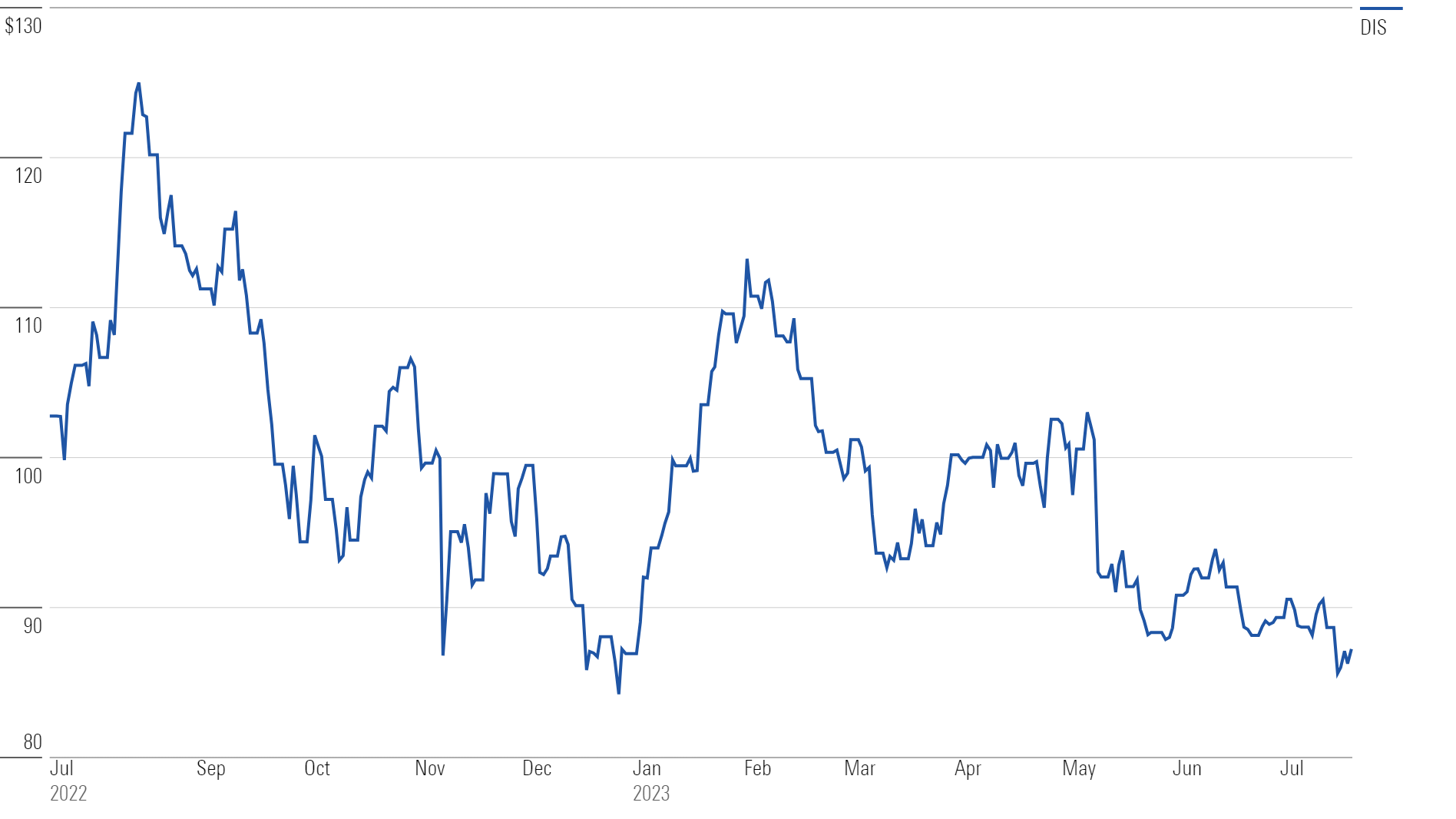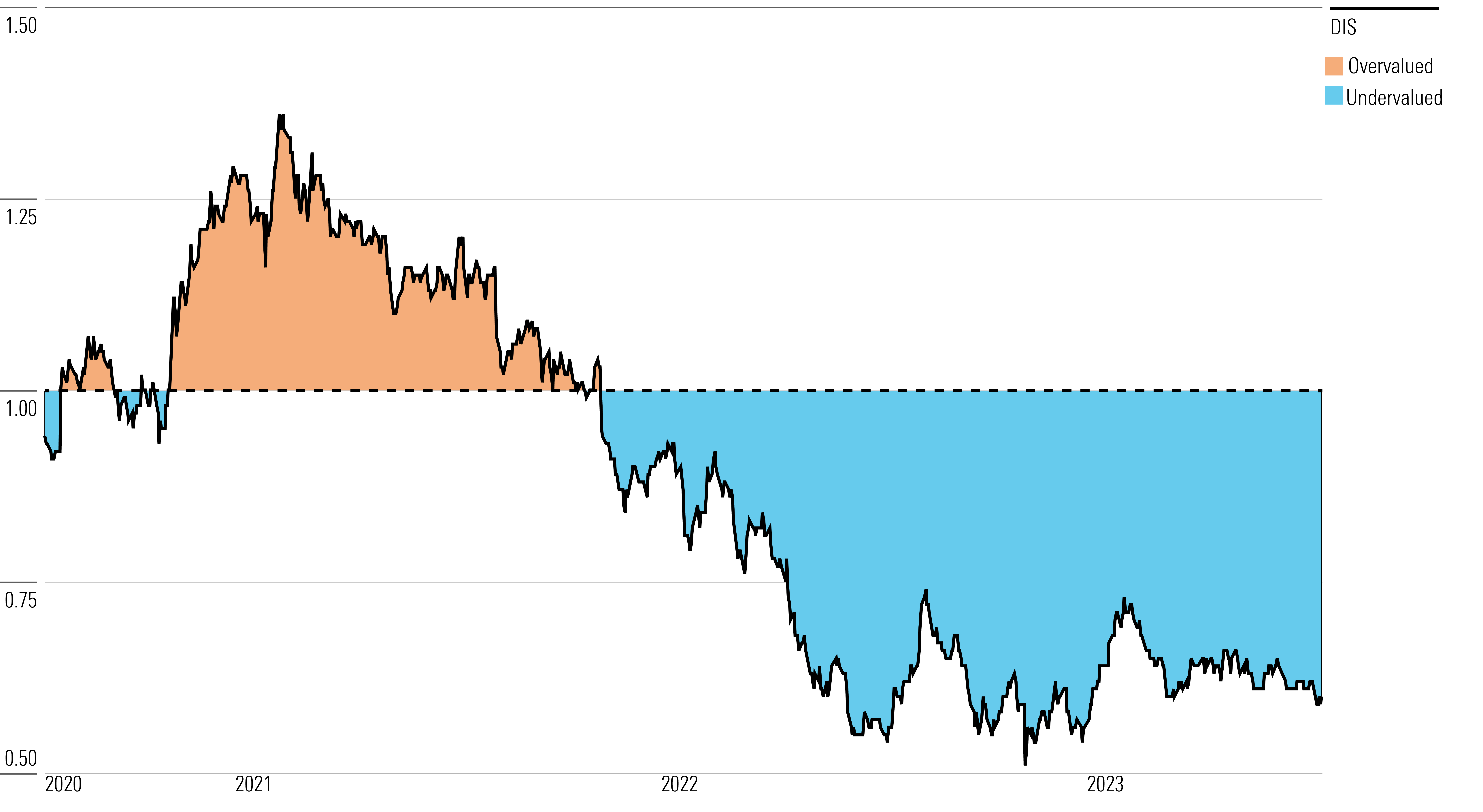Going Into Earnings, Is Disney Stock a Buy?
Watching profitability on streaming, Iger’s contract, and theme park attendance.

The Walt Disney Company DIS is set to release its fiscal third-quarter earnings report on August 9, 2023, after the close of trading. Here’s Morningstar’s take on what to watch for in Disney’s earnings and stock.
Walt Disney Company Stock at a Glance
- Fair Value Estimate: $145
- Morningstar Rating: 4 stars
- Morningstar Economic Moat Rating: Wide
- Morningstar Uncertainty Rating: High
What to Watch for In Disney’s Quarterly Earnings
- A direct-to-consumer path to profitability: Are losses here still decreasing sequentially, and is management still hopeful to record a breakeven quarter in the fall of 2024?
- Bob Iger’s contract renewal: What are the CEO’s key initiatives over the next four years—not only for the business but also for talent management?
- Theme park attendance: With reports of weak attendance in June and July, is there any discussion about the parks segment?
- Recent issues for theatrical Disney films: Are these problems one-offs, or is something wrong with the process?
Disney Stock Price

Fair Value Estimate for Disney
At a 4-star rating, Disney stock is undervalued compared with our fair value estimate.
Disney’s $145 fair value estimate reflects slower subscriber growth and reduced losses from streaming. The company expects an average annual top-line growth of 6% until fiscal 2027, with losses in the streaming segment continuing until fiscal 2024, along with a decline in linear advertising and margins. The company’s linear television networks are projected to have flat average annual sales growth during fiscal years 2023-27, compensating for the loss of subscribers at ESPN and other pay-TV channels with domestic price increases. Despite consumer concerns about the economy, fiscal 2023 admissions revenue is expected to exceed fiscal 2019 levels, and similar growth is predicted for merchandise, food and beverage, and resorts revenue. The parks and consumer segments are projected to experience normalized growth of 5% over the next five years after a strong rebound in 2022.
The DTC segment is estimated to achieve 12% average annual growth due to strong subscriber growth for Disney+ and Hulu, along with further price increases. The firm anticipates that Disney-branded services will reach 235 million paid subscribers by the end of fiscal 2027, assuming international rollout and improved penetration in Western markets, with the segment expected to post its first positive annual operating income in fiscal 2025.
Disney’s overall operating margin is forecasted to improve to 21% in fiscal 2027, primarily due to the DTC segment’s gains and margin improvements at theme parks, offsetting the margin decline in linear operations.
Read more about Disney’s fair value estimate.
Disney Historical Price/Fair Value Ratios

Economic Moat Rating
We assign Disney a wide economic moat due to its strong pricing power in the media networks segment and branded businesses. The 2019 addition of entertainment assets from 20th Century Fox is expected to help the company generate excess returns on capital despite the competitive media and streaming landscape.
Disney’s media networks, including ESPN and ABC, hold significant importance in the traditional pay-TV bundle, and their profitability is still supported by strong subscriber fees and advertising revenue. The Fox acquisition has further strengthened the firm’s position in the pay-TV network lineup, with platforms like FX and FXX adding critically acclaimed original series to Disney+ and Hulu, enhancing those platforms’ competitive position in the streaming landscape.
The success of Disney’s studio capabilities, bolstered by the Fox acquisition, drives the firm’s DTC ambitions with Disney+, Hulu, and ESPN+. Disney’s ability to monetize its renowned characters and franchises across various platforms, along with the continuous expansion of its library through new franchises, contributes to its long-term value generation.
Read more about Disney’s economic moat rating.
Risk and Uncertainty
Based on the competitive media markets Disney operates in and its revenue exposure to advertising and parks, which are both dependent on the economy, we give the company a Morningstar Uncertainty Rating of High.
Disney faces potential challenges when adapting to the evolving media landscape, with increasing pay-TV rates possibly leading to subscription cancellations or reductions. ESPN’s high affiliate fees may slow revenue growth if pay-TV penetration decreases, and rising sports rights costs could pressure margins. Economic weaknesses could impact ad-supported broadcast networks, theme parks, and consumer products. The filmed entertainment segment’s profitability is subject to hit-or-miss results in the movie industry, particularly with Disney’s focus on blockbuster films. Additionally, labor relations pose environmental, social, and governance risks, as Disney has faced lawsuits alleging discrimination and harassment, affecting talent attraction and retention in competitive fields.
Read more about Disney’s risk and uncertainty.
DIS Bulls Say
- The parks and resorts segment will rebound strongly from the pandemic, as families still view the parks as prime vacation destinations.
- Disney+ has a long runway for growth in both the United States and internationally. The firm’s original series and expanding library will drive this growth.
- Although making movies is a hit-or-miss business, Disney’s popular franchises and characters reduce this volatility over time. Additionally, the firm’s annual slate does not generally rely on one big picture, reducing the downside of a flop.
DIS Bears Say
- The business model of the media networks division depends on the continued growth of affiliate fees. As pay-TV subscribers continue to decline, any slowdown in the growth of these fees could tremendously hit profitability.
- The streaming space is becoming increasingly crowded. Disney may need to continue to fund losses in this segment beyond fiscal 2024.
- Developing mass-market hit programs can be unpredictable, especially as media fragmentation continues. The race to attract and retain talented creatives is and will remain very competitive and expensive.
This article was compiled by Saaketh Tirumala.
The author or authors do not own shares in any securities mentioned in this article. Find out about Morningstar’s editorial policies.

/s3.amazonaws.com/arc-authors/morningstar/fab4d3e1-7951-4575-a38d-fd2028ad4ae3.jpg)
/cloudfront-us-east-1.images.arcpublishing.com/morningstar/ECVXZPYGAJEWHOXQMUK6RKDJOM.jpg)
/cloudfront-us-east-1.images.arcpublishing.com/morningstar/KOTZFI3SBBGOVJJVPI7NWAPW4E.jpg)
/cloudfront-us-east-1.images.arcpublishing.com/morningstar/V33GR4AWKNF5XACS3HZ356QWCM.jpg)
:quality(80)/s3.amazonaws.com/arc-authors/morningstar/fab4d3e1-7951-4575-a38d-fd2028ad4ae3.jpg)